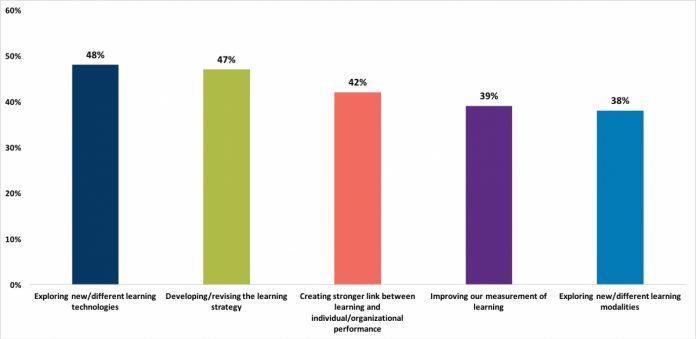
The tide finally appears to be turning for learning technology. After a decade of inertia, the top learning priority for organizations surveyed in Brandon Hall Group’s 2016 Learning Technology Study is exploring new or different learning technologies. Over the next 12 months, new technologies take priority over even perennially important initiatives such as developing the learning strategy and improving the link between learning and performance.
Figure 1: Top 5 Learning & Development Priorities
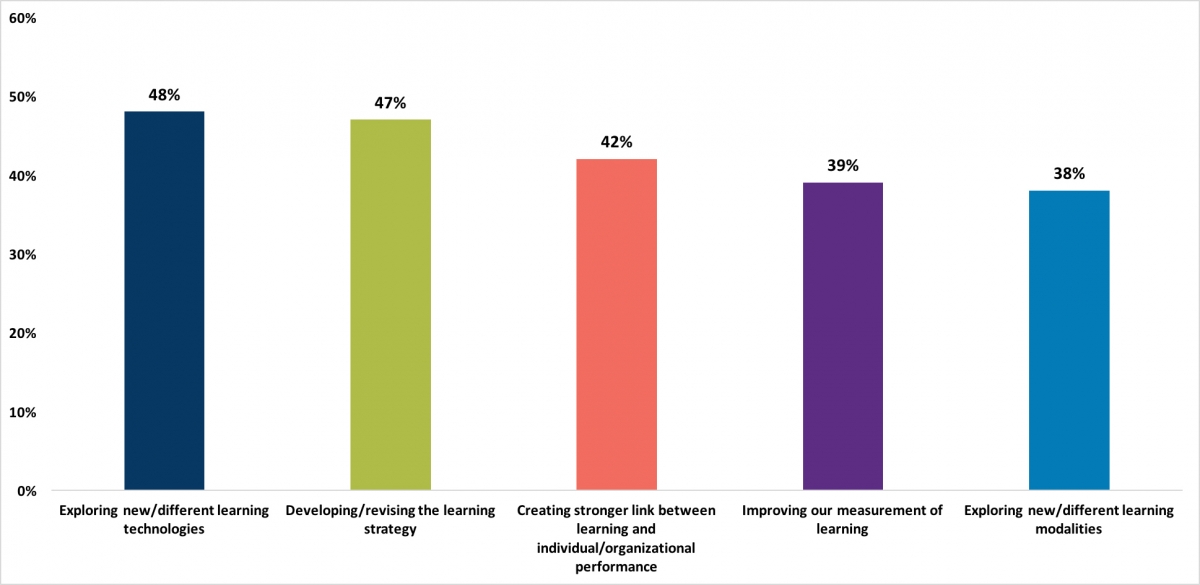
Source: 2016 Brandon Hall Group Learning Technology Study (n=302)
Combine that with the fact that exploring new or different modalities rounds out the top five, and this data suggests that organizations finally are getting serious about changing the way they deliver learning. For years, organizations have been talking about new technologies, but have continued to deliver a two-dimensional learning experience. Even as mobile technology has become more ubiquitous and learners clamored for collaboration tools, companies have been developing learning that essentially consists of classroom instruction and e-learning modules, which—if you subscribe to the 70/20/10 model—only represents approximately 10 percent of how people learn at work.
Satisfaction with current learning technology remains solidly mediocre across the board, as it has been for the last three or four years. Not one aspect of learning technology scored better, on average, than 2.9 on a 4-point scale (or 72 on a 100-point scale, no better than a solid C.) And similar to previous years, 44 percent are actively seeking to replace their current platform within the next two years (and more than half of them say within one year).
But the technology journey may be rough for many organizations. Only 20 percent of organizations in our research have fully mature, robust learning technology strategies governing the implementation of these solutions. This leaves the rest without any clear guidance or a roadmap forward, which also feeds into their dissatisfaction. In essence, these organizations are simply acquiring technology, rolling it out, and hoping for the best. It has been proven time and time again that technology cannot fix a bad process. An organization needs a clear vision on how learning technology is going to help it move forward and achieve business goals if it wants that technology to truly be effective.
Seeking Better User Experience
For the 44 percent of companies looking to make a change (that’s up from 38 percent last year), improving the user experience is the number one reason.
Figure 2: Top 5 Reasons for Switching Learning Technology
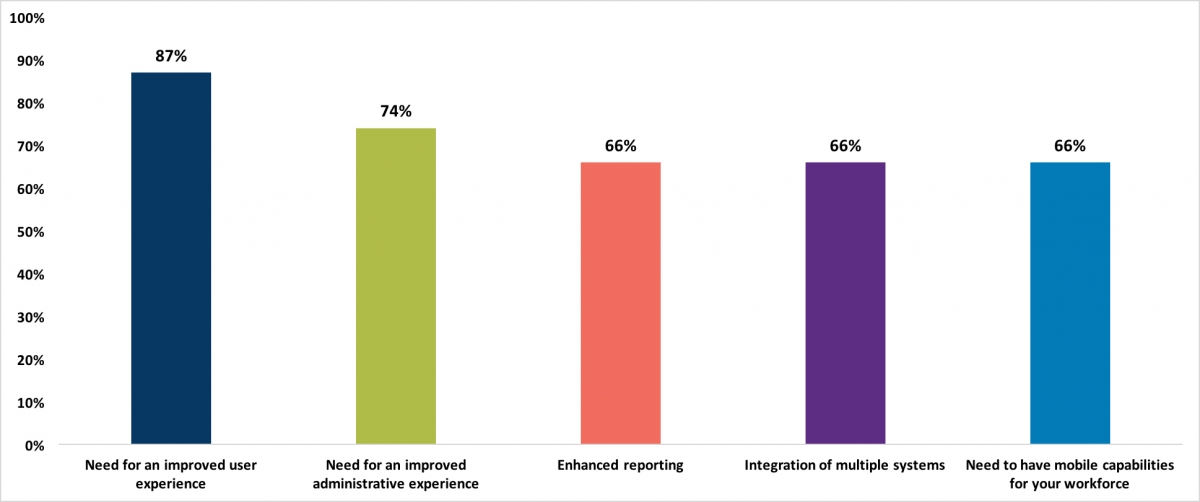
Source: 2016 Brandon Hall Group Learning Technology Study (n=302)
If we look at these results together—the embrace of new technology and a desire for a better learner experience—we find ourselves at a pivot point where companies finally begin to use technology to deliver a variety of learning experiences that are more relevant to learners and based on a model whose foundation can be found in the 70/20/10 framework.
70/20/10 has been around for more than two decades, and essentially posits that 10 percent of what people learn at work comes from formal classroom and course instruction, 20 percent comes from informal sources and collaborating with colleagues, and the remaining 70 percent comes from on-the-job, experiential learning. While we do not consider this to be a precise formula for organizational learning, it does provide solid insight into how people learn.
Using the framework as a guide, organizations can leverage technology to deliver a much more effective, well-rounded learning experience, as illustrated in Figure 3.
Figure 3: Benefits of the 70/20/10 Framework
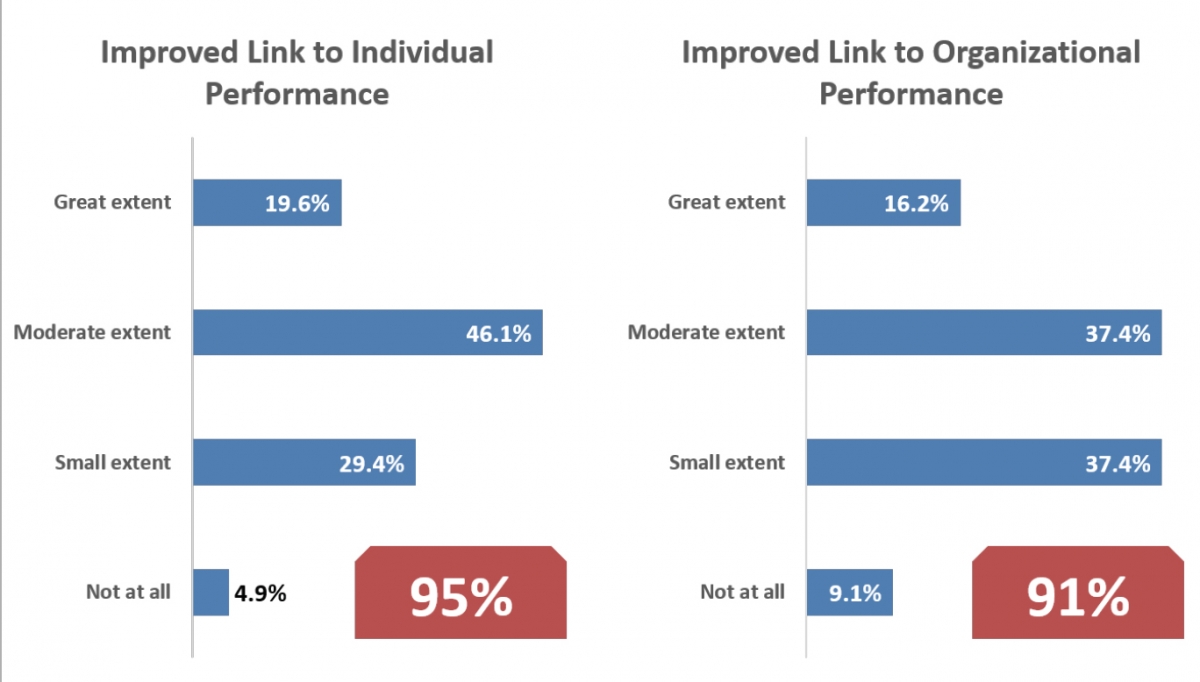
Source: 2016 Brandon Hall Group Learning Technology Study (n=302)
While our research indicates that organizations believe they could be getting better results from all of their learning technology, it is more important to understand why.
While there is always room for improvement, we currently are seeing some of the most innovative learning technology in a long time. Instead, this study shows that a company’s success or failure with learning technology rests far more with strategy (or lack thereof).
Organizations that do not take the time to build a solid strategic foundation on which to build their learning technology ecosystem not only end up dissatisfied, they end up stuck in place, shackled by outmoded technology that prevents them from moving forward.
Conversely, companies that start with a robust strategy are able to better leverage existing technology, as well as make decisions about which technologies will serve them in the future. For example, there is overall a heavy reliance on technology for formal learning delivery, including in-person classroom scheduling, e-learning content delivery, and virtual classrooms. Yet forward-looking organizations with robust learning technology strategies are keenly focused on broadening their approach to include technologies that enable more informal, collaborative, and experiential learning. Figure 4 presents a few examples.
Figure 4: Comparative Importance of Informal/Experiential Learning Functionalities
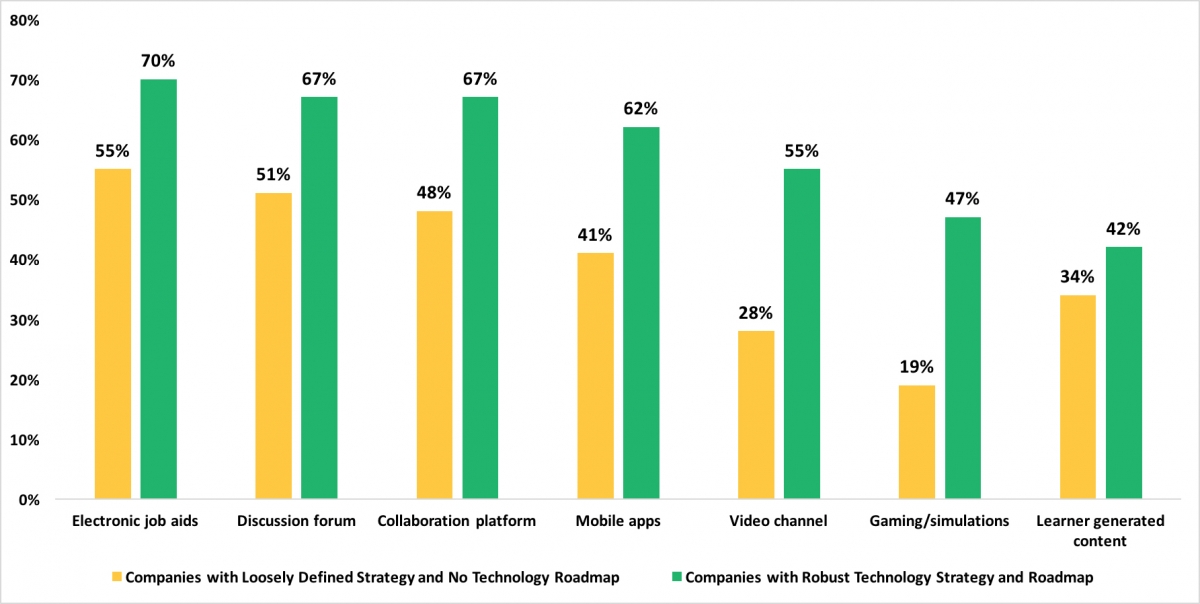
Source: 2016 Brandon Hall Group Learning Technology Study (n=302)
Another important distinction between developing and mature technology programs is the need for systems integration. Companies with more fully developed strategies are also more likely to have their technology integrated with other systems. Integration is critical moving forward as technology advances and data analysis across the business is required. Looking ahead, more than two-thirds of companies are looking for technology platforms that offer a suite of solutions already integrated, rather than a best-of-breed solution.
Below are four critical calls for change to further diversify learning delivery to improve individual and organizational results through the more effective use of technology. These assertions are supported by the findings of the 2016 Brandon Hall Group Learning Technology Study, which surveyed more than 300 learning and business leaders from more than 20 countries and industries in the spring of 2016. An executive summary of Brandon Hall Group’s signature report on the research can be found here.
Critical Calls for Change
1. Focus on the Learner. This may seem obvious, but the fact of the matter is that learners are often near the end of a long list of priorities when it comes to organizational learning. There are stakeholders, budgets, compliance challenges, reporting issues, skill gaps, competencies, and a whole array of concerns that put various amounts of pressure on the Learning function. Amid all that pressure, the learner can be forgotten, left to consume training that feels irrelevant and unrelatable. Not only have technology solutions not been terribly user-friendly, but organizations have not been focusing their strategies on learners either. In other words, a platform that has a user-friendly interface is not going to make up for content that is not relevant or a strategy that eschews the needs of the learners.
An improved user experience is the No. 1 reason organizations want to switch technologies. Some 87 percent of survey respondents said an intuitive, user-centric interface was the most critical new requirement for a learning management system, and 83 percent said the ability to create the intuitive user-centric interface was the most critical competency for their next provider.
2. Explore New Learning Modalities. In order to create these learning experiences, organizations need to step outside the comfort zone of the classroom and the course. Not that these modalities should be abandoned. They are, and will continue to be, a critical learning delivery method. However, by themselves the classroom and the course do not comprise a complete, effective, and attractive learning experience, especially against the backdrop of the blended learning framework and digital-native Millennials who soon will become the majority of the workforce. In fact, previous Brandon Hall Group research found that informal peer-to-peer learning, coaching, and mentoring, and on-the-job exercises were considered to be nearly as effective as instructor-led classroom training, but were used 65 percent to 67 percent less often. This is a major opportunity that organizations must seize, and this latest research indicates organizations finally are poised to address it.
3. Leverage Technology for a Truly Blended Learning Experience. Companies often provide classroom training and Web-based training and call it blended. But a truly blended approach involves multiple modalities that can meet the various needs of a diverse learning audience. Organizations need to embrace technology that allows them to focus on the 80 percent of learning that is not formal classroom or Web-based training. This functionality exists within many of the LMS platforms available, but companies have been obsessively focused on creating courses and filling classrooms.
The learning strategy itself needs to recognize the existence, strengths, and value of informal and experiential learning and the technology that must be used to execute it. The technology available today allows organizations to provide necessary formal training and expand and enhance that experience with collaboration, mobility, and context. An embrace of a blended environment is the foundation for changing learning from a disconnected event to part of a continuous experience.
4. Realize the Potential in Mobile, Social, and Collaborative Technologies. In order to execute on a more expansive learning strategy, new technologies need to be leveraged. There is no doubt that mobile devices will play an increasingly integral role in how people live, work, and learn. The potential for employees to have everything they need to know at their fingertips is a quantum leap forward for performance support. Even in the simplest use, mobile devices provide learners with the opportunity to interact with learning when, where, and for as long as they want to. The personalization of the mobile device also provides new possibilities for more contextual, relevant learning.
As multiple studies have shown, people learn more, are more engaged, and retain knowledge longer when they are able to collaborate. Schools and universities are embracing this concept even more so than corporations, providing students with both physical and digital spaces to work together and learn from one another. Social and collaborative tools within learning technologies allow companies to promote and leverage the 20 percent of the 70/20/10 model and make collaborative learning easier, more effective, and more impactful.
David Wentworth is principal Learning analyst for Brandon Hall Group, an independent human capital management (HCM) research and advisory services firm that provides insights around key performance areas, including Learning and Development, Talent Management, Leadership Development, Talent Acquisition, and HR/Workforce Management.




